How to Grow Oregano
This post may contain affiliate links, which means that I may receive a commission if you make a purchase using these links. As an Amazon Associate I earn from qualifying purchases.
Spice up your kitchen with homegrown oregano! Whether in pots or garden beds, oregano is a versatile herb that adds depth and flavor to your favorite dishes. Learn how to grow oregano and get ready to infuse your recipes with flavor.
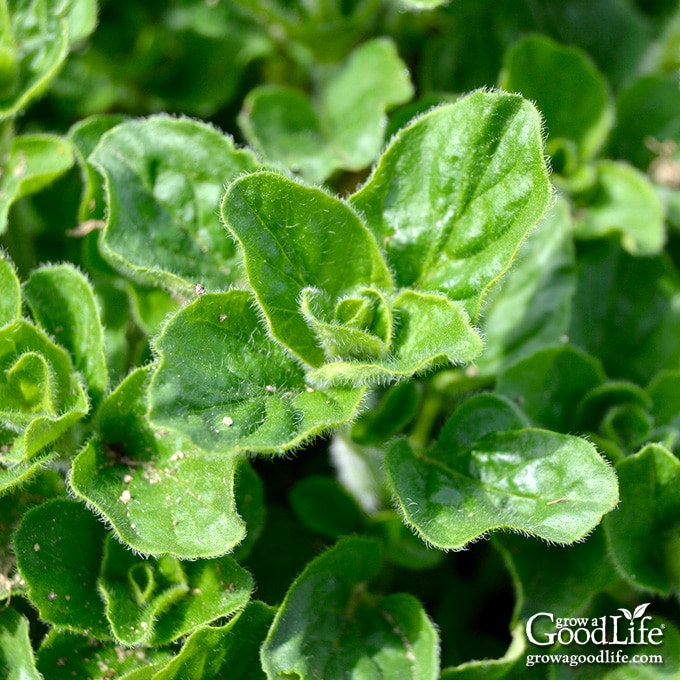
I love growing oregano. Not only is it a low-maintenance herb, but it also rewards me with its resilience and faithful return year after year. It’s usually the first plant to pop up in my garden as soon as spring arrives, announcing the start of a new gardening season.
Oregano is a wonderful herb that can be used fresh and dried to enhance the flavor of various dishes. It is a key ingredient in Italian, Mediterranean, and Greek cuisines. The robust and slightly bitter taste adds a delightful complexity to pizzas, pasta sauces, grilled meats, roasted vegetables, and more.
Whether you choose to plant oregano in pots, in a dedicated herb garden, as a companion to other vegetables, or even grow indoors, this guide will provide you with the knowledge and tips to cultivate thriving oregano plants that will provide plenty of fresh harvests.
We will guide you through choosing a variety, creating an ideal growing environment, harvesting, and preserving. In addition, we will explore different propagation methods, such as growing oregano from seed or creating new plants through stem cuttings and plant divisions. Finally, we will provide helpful tips and advice every step of the way.
About Oregano
Oregano (Origanum vulgare) is a flavorful herb widely known for its culinary uses and aromatic qualities. With its vibrant taste and distinct aroma, oregano is a staple ingredient in many cuisines worldwide. This herb belongs to the mint family, Lamiaceae, and shares many of the same growing conditions.
Oregano has a rich history dating back to ancient times. It is believed to have originated in the Mediterranean region, specifically in Greece and Italy. The word “oregano” is derived from the Greek words “oros,” meaning mountain, and “ganos,” meaning joy. The herb was highly regarded in ancient Greek and Roman cultures for its flavor and medicinal properties. In addition, Oregano was traditionally used for its antibacterial and anti-fungal properties and in ancient rituals and ceremonies.
Today, oregano is cultivated in various regions across the globe, and different varieties and cultivars have been developed, each with its unique characteristics and flavors.
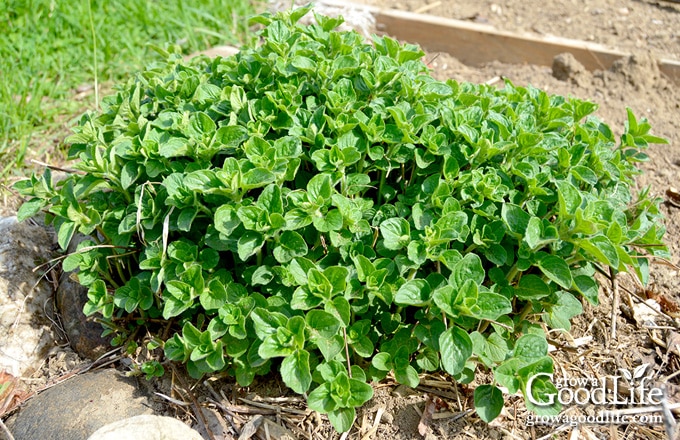
Types of Oregano to Grow
There are many types of oregano, but we will focus on Mediterranean oregano varieties (Origanum spp.) for this growing guide because the growing conditions are similar.
- Greek Oregano: If you’re looking for a resilient perennial herb that returns yearly, Greek Oregano (Origanum heracleoticum) is the way to go. Once the plants are established, they require minimal attention, are resistant to drought, and will thrive without much assistance. This hearty herb will survive most winters in USDA Zones 5 to 9. Its slightly peppery and pungent taste makes it an ideal seasoning for savory dishes such as grilled meats, roasted vegetables, and tomato-based sauces.
- Italian Oregano (Origanum x majoricum), also known as Sicilian oregano, is a hybrid mix of sweet marjoram and oregano. It has a milder flavor than Greek oregano but is still highly versatile in cooking. The plant bears pale green leaves and white flowers. It is a popular ingredient in Italian cuisine, especially in pasta sauces, pizzas, and herb-infused oils, owing to its light and delicate flavor. Italian oregano is a perennial herb in warmer climates, but it is often grown as an annual in cooler regions.
- Sweet Marjoram (Origanum majorana) is closely related to oregano and shares a similar flavor profile. However, it has a milder and sweeter taste, making it a delightful addition to soups, stews, and herb blends. The short and bushy plants make sweet marjoram a great choice for containers and small spaces. The plants are not as cold tolerant as other varieties, but they can be grown as an annual in cooler regions.

Tips for Growing Oregano
Oregano is a great addition to any herb garden. This section will explore tips for successfully growing oregano and ensuring a bountiful harvest.
When to Plant Oregano
Oregano is ideally planted in early spring by sowing seeds or transplanting seedlings. This gives the plant time to become established before the warmer months.
For an early start, you can start seeds indoors under lights about 6 to 8 weeks before your average last frost date. Then, plan to transplant oregano seedlings 2 to 4 weeks after your average last frost date. This timing allows the soil to warm up and reduces the risk of frost damage to the young plants.
Garden Selection
As a sun-loving herb, oregano thrives in full sun but can also tolerate partial shade. Select a growing location that receives at least six hours of sunlight daily for optimal growth and flavor development. If you are growing oregano in a warmer climate, choose an area that receives partial shade in the afternoon.
Oregano also appreciates well-draining soil that is neutral or alkaline in pH. If the soil tends to retain excessive moisture, consider amending it with organic matter or growing oregano in raised beds to ensure adequate drainage to prevent root rot.
Additionally, when choosing a spot in your garden for oregano, consider its growth habits. Some varieties can grow quite tall and expand each year. Therefore, it’s advisable to plant in an area where it can spread without overcrowding other plants.
How to Start Oregano from Seed Indoors
Growing oregano from seed indoors allows you to get a head start on the growing season and ensures healthier and stronger transplants. Start seeds indoors approximately 6 to 8 weeks before your area’s last predicted frost date. This timing allows the seedlings to develop and be ready for transplanting when the outdoor conditions are suitable. Follow these steps to successfully start oregano seeds indoors:
- Sow the Seeds: Fill a container with a damp seed starting mix, then sprinkle a pinch of oregano seeds on top of the soil. The seeds need light to germinate, so don’t cover them. Instead, press the seeds into the soil to ensure good contact, then mist with water and cover the containers with a humidity dome to hold in moisture.
- Control the Environment: Oregano seeds need light, warmth, and moisture to germinate. Place the tray under grow lights in a warm area around 70 to 75°F. Consider using a seedling heat mat to maintain the optimal temperature. Additionally, mist with water as needed to keep the soil evenly moist but not overly saturated.
- Germination Period: Oregano seeds typically germinate within 7 to 10 days under optimal conditions. Keep an eye on the tray and remove the humidity dome once the seeds have germinated. At this stage, the seedlings will require more air circulation.
- Provide Ample Light: Once the seeds sprout, adjust the lights so they are about 2 inches away from the tops of the plants. This will help promote healthy growth and prevent the oregano seedlings from becoming leggy.
- Thin if Needed: If the seedlings are growing well and have enough space, thinning may not be necessary. However, if the seedlings are struggling because of overcrowding, you can thin them by cutting the unwanted seedlings at the soil level.
You can learn more about using grow lights and starting seeds indoors in the following articles: Using Grow Lights for Starting Seeds and 10 Steps to Start Seeds Indoors.
Transplanting Oregano Seedlings
To successfully transplant your oregano seedlings into their permanent growing location, follow these steps:
- Harden Off the Seedlings: About 7 to 10 days before transplanting, begin hardening off the oregano seedlings. Start by placing them outdoors in a sheltered spot for a few hours each day, gradually increasing the time and exposure to direct sunlight. This gradual acclimation helps the seedlings adjust to the outdoor environment. Learn more about How to Harden Off Seedlings.
- Prepare the Garden Bed: Before transplanting, remove any weeds and incorporate 2 to 3 inches of finished compost into the soil. If the soil is dry, water it thoroughly the day before planting to ensure adequate moisture for the seedlings
- Choose the Right Timing: Select a late afternoon or evening time for transplanting, as it allows the seedlings to adjust to their new surroundings without the added stress of direct sunlight. Transplanting during cooler hours also reduces water loss and supports better establishment.
- Dig Planting Holes: Dig holes that are deep and wide enough to accommodate the root system of the oregano seedlings. Space the holes according to the recommended spacing for oregano plants, typically around 12 to 18 inches apart.
- Transplant with Care: Gently remove the oregano seedlings from their containers or seedling trays, taking care not to damage the roots. Place each seedling into a planting hole, ensuring that the top of the root ball is level with the soil surface. Fill the hole with soil and gently tamp it down.
- Water Thoroughly: After transplanting, water the seedlings well to settle the soil around the roots and provide moisture for their initial growth. This helps minimize transplant shock and promotes healthy establishment.
- Consider Frost Protection: Oregano seedlings that have been properly hardened off can tolerate light frosts. However, if heavy frost is expected, it may be beneficial to provide temporary protection by covering the transplanted seedlings with row covers or a lightweight fabric to prevent damage.
By following these steps, including the important process of hardening off the seedlings, you can give your transplanted oregano seedlings the best chance of thriving in their new garden location.
Direct Sowing Seeds
Direct sowing is another method for growing oregano and is particularly suitable for gardeners who prefer to sow seeds directly in the garden rather than starting indoors. Follow these steps to successfully direct sow oregano seeds:
- Choose the Right Time: Wait until all danger of frost has passed and the soil has warmed up in spring before direct sowing oregano seeds. The ideal soil temperature for germination is around 70°F.
- Prepare the Soil: Select a well-draining location in your garden with full sun or partial shade. Clear the area of any weeds or debris and loosen the soil using a garden fork, then smooth the surface.
- Sow the Seeds: Take a pinch of oregano seeds and sprinkle them evenly over the prepared soil surface. The seeds need light to germinate, so do not cover them but lightly press the seeds into the soil using your hand or the back of a rake, ensuring good seed-to-soil contact.
- Water the Seeds: After sowing, gently water the area with a fine mist or a gentle sprinkle to settle the seeds into the soil. Keep the soil consistently moist.
- Thinning: Oregano seedlings typically do not require thinning. However, if the plants seem overcrowded, you may thin them to provide more space for each plant to grow. Use scissors to cut the unwanted seedlings at the soil level, being careful not to disturb the roots of the remaining seedlings.
Propagating Oregano from Cuttings
Propagating oregano from stem cuttings is a great way to start new plants genetically identical to the parent plant, ensuring consistent flavors and characteristics. Plants grown from cuttings also establish quicker than ones grown from seeds.
The best time to take stem cuttings is in spring when the plant is producing new growth and isn’t flowering. First, choose a healthy plant to take cuttings. Look for young and flexible stems that are not woody.
Cut 5-inch sections from the top of the stems using clean and sharp pruning shears. Next, remove the lower leaves from the bottom half of the cutting, leaving only a few sets of leaves at the top.
There are two ways you can root oregano cuttings. You can place the stems in a glass of water or stick the stems in a growing medium, such as potting mix or vermiculite.
- Water Method: Place the prepared cuttings in a glass or container filled with clean water. Make sure the bottom nodes of the cuttings are submerged in the water. Place the container in a bright location but away from direct sunlight. Change the water every few days to prevent stagnation and maintain freshness.
- Soil Method: Fill a small pot or seed tray with a well-draining rooting medium, such as a mixture of perlite and vermiculite or a seed-starting mix. Insert the prepared cuttings into the soil, burying the bottom nodes. Lightly press the soil around the stem to firm it in.
Regardless of the rooting method, keep the cuttings warm and humid, ideally around 70 to 75°F. Place a clear plastic bag or a humidity dome over the cuttings to create a mini greenhouse effect that retains moisture. Make sure to ventilate the covering periodically to prevent mold or fungal growth.
Roots should develop in about 2 to 4 weeks. Once the roots are about 1 to 2 inches long, transplant the cuttings into individual pots or directly into the garden. Plant them at the same depth as they were in the rooting medium. Water well until the plants become established and show new growth.
How to Propagate Oregano from Divisions
Propagating oregano from divisions is another effective method to multiply your plants. Divisions involve separating an established oregano plant into smaller sections, each with its own root system. Oregano can present some challenges due to its dense root system, but the plant is hardy and can withstand some rough treatment.
The best time to divide oregano is in early spring when new growth appears. At this time, the plant is actively growing, and dividing it will give the sections time to become established before the heat of summer.
Following these steps will help you successfully propagate oregano from divisions and establish new plants in your garden.
- Prepare the Plant: Thoroughly water the oregano plant the day before dividing it to ensure the roots are well hydrated.
- Prepare the Growing Area: Remove any weeds and loosen the soil in the planting area. Dig individual planting holes wide and deep enough to accommodate the divided sections. Mix in some finished compost.
- Dig up the Oregano: Carefully dig up the entire plant. First, use a garden fork to loosen the soil around it, then use a shovel to lift the plant out of the ground, trying to preserve as much of the root system as possible.
- Divide the Plant: Look for divisions in the roots or areas where the plant has naturally separated. Use your hands, a clean garden knife, or pruners to divide it into smaller sections, ensuring each division has its own set of healthy roots and foliage. Some root breakage may occur, but oregano is resilient and can recover well.
- Replant the Oregano: Place each division into a planting hole, making sure the top of the root ball is level with the soil surface. Backfill the hole with soil and gently firm it around the roots.
- Water Well: Water thoroughly to settle the soil and provide moisture. Maintain regular watering to keep the soil evenly moist, and then reduce watering once the plants become established and develop new growth.
Growing Oregano in Containers
Oregano is very well-suited for containers, making it an excellent option for gardeners with limited space or who prefer to grow herbs indoors. Growing oregano in pots or containers allows easy access to this flavorful herb right at your fingertips. Here are some tips to successfully grow oregano in containers:
- Select a Large Container: Choose a pot or container at least 12 inches in diameter, 12 inches deep, and with drainage holes at the bottom. Oregano has a vigorous root system, so you will need a container to give it space for root development.
- Use Good Soil: Use a well-draining potting mix for container gardening. Pre-moisten the potting mix so it is well-hydrated but not soggy. Then fill the container leaving several inches at the top.
- Plant the Oregano: Dig a hole in the center of the pot, remove the oregano plant from its container, and place it in the hole so that the top of the root ball is level with the soil surface. Then backfill with additional soil mix, lightly firming it around the roots. Water well to settle the soil and remove air pockets.
- Give it Full Sun: Choose a location for your container that receives full sun for at least 6 to 8 hours daily. Oregano thrives in warm and sunny conditions, so placing it in a spot with adequate sunlight is crucial for optimal growth and flavor development.
- Water as Needed: Oregano prefers slightly dry conditions, so it’s important not to overwater. Instead, allow the top inch of the soil to dry out between watering sessions, and then water thoroughly until the excess water drains out of the bottom of the container. Avoid letting the plant sit in standing water, as it can lead to root rot.
- Fertilize Regularly: To promote healthy growth and flavor, feed your oregano plant with a balanced, water-soluble fertilizer once a month during the growing season. Follow the instructions on the fertilizer package for the correct dilution ratio.
- Harvest and Prune: Regular pruning helps to keep your oregano plant compact, encourages new growth, and enhances the flavor of the leaves. Harvest and prune by regularly pinching or trimming back the stems, focusing on removing the top few inches of growth. This will help prevent the plant from becoming leggy and encourage bushier growth.
- Overwinter Indoors: If you live in an area with harsh winters, consider bringing your container-grown oregano indoors before the first frost. Place it in a sunny spot near a window or under grow lights. Reduce watering during the winter months, as the plant’s growth slows down. You can learn more about growing herbs indoors in the following article: Grow Herbs Indoors: Herbs that Thrive Inside.
Following these tips, you can enjoy a bountiful harvest of fresh oregano from your containers. Whether you have a small balcony, a sunny windowsill, or a spacious patio, growing oregano in pots allows you to savor the flavors of this versatile herb throughout the year.
How to Care for the Plants
Once established, oregano is resilient and doesn’t require much maintenance. In this section, we will explore the effortless care routines that will keep your oregano plants thriving.
Watering
To ensure healthy growth, water your plants regularly at first. But once your oregano plants are established, they prefer slightly dry conditions, so be careful not to overwater them. Whether planted in the ground or containers, it’s best to let the top inch of soil dry out between waterings.
When watering, thoroughly soak the soil until water drains out of the bottom of the container or seeps into the ground. This encourages deep root growth. In hot and dry climates, oregano may require more frequent watering.
Weeding and Mulching
Weed regularly, especially when the plants are young. Remove weeds by hand, taking care not to disturb the oregano plants. Applying a layer of organic mulch around the plants can help suppress weed growth. Once the plants are established, their hearty roots and leafy growth discourage weeds.

Fertilizing
Oregano plants generally do not require excessive fertilization, especially if the soil is already rich in organic matter. However, a light application of balanced organic fertilizer or a slow-release granular fertilizer in early spring can provide the necessary nutrients for healthy growth.
Follow the instructions on the fertilizer package for the recommended dosage and frequency. Avoid over-fertilization, which can lead to excessive foliage growth and reduced flavor.
Pruning
Regular pruning is beneficial for oregano plants to promote bushier growth and maintain a compact shape. Prune oregano after it has finished flowering or when it becomes overgrown. Using clean and sharp pruning shears, trim back the top few inches of growth, cutting just above a leaf node or a pair of leaves. This encourages the plant to produce new shoots and leaves. Regular pruning also helps maintain the flavor and aroma of the leaves.
Pests and Diseases
Oregano plants are resistant to pests and diseases, but some common issues may arise. Here are a few problems that can affect oregano, along with organic control methods:
- Aphids: These small, soft-bodied insects can cluster on the leaves and stems, sucking sap from the plant. They tend to be more of a problem with young plants. As oregano matures, it develops a scent that deters aphids. To control aphids, spray the affected plant parts with a strong stream of water from a hose, trim off affected branches, and let nature come to the rescue. Eventually, beneficial insects like ladybugs or lacewings will arrive and feed on aphids.
- Spider Mites: These tiny pests are often found on the undersides of leaves and can cause yellowing and stippling. Increase humidity around the plant by misting the leaves regularly. You can also spray the plant with water to dislodge the mites.
- Powdery Mildew: Powdery mildew appears as a white, powdery coating on the leaves. Improve air circulation around the plants by pruning and avoiding overhead watering.
- Root Rot: Oregano may also develop root rot from overly wet soil. A sure sign of root rot is wilting leaves, yellowing foliage, or a rotten odor coming from the roots. If not addressed, crown rot will eventually develop, and the plant will die from the center outwards. You can save the plant by digging it up, trimming away the rotted roots, and replanting it in fresh, well-draining soil. You can avoid root rot by not overwatering and planting oregano in well-draining soil.
By promptly identifying and addressing these pests and diseases, you can ensure the health and vitality of your oregano plants.
Dealing with Oregano Spreading
Oregano is in the mint family and shares its vigorous growth tendencies and ability to spread in the garden. While this can be good in some situations, it can also become invasive if not properly managed. Here are some tips for dealing with oregano spreading from roots, runners, and seeds:
- Root Spreading: Oregano has an extensive root system that can spread underground, expanding the plant’s width yearly. Consider planting oregano in containers or raised beds with defined boundaries to control root spreading. This will help contain its growth and prevent it from overtaking other plants.
- Runner Growth: Oregano plants can also produce runners, also known as stolons, which can extend horizontally and give rise to new plants. If you want to control the spread of oregano, regularly monitor for these runners and trim them back to prevent the establishment of new plants. Alternatively, you can redirect the runners into desired areas or pots to create new oregano plants.
- Seed Dispersal: Oregano produces small, dry seed capsules that contain numerous tiny seeds. Wind can self-sow these seeds, leading to the unplanned growth of oregano in unexpected spots. To prevent seeds from spreading, trim and remove spent flower heads before they can produce seeds. This practice will help control self-seeding and minimize its spread.
- Regular Maintenance: Inspect your garden frequently for signs of oregano growth in unwanted areas. At this point, treat the plants as weeds and promptly remove them by digging them out.
Oregano’s spreading tendencies can be ideal for creating a dense ground cover or filling in empty spaces. However, with these tips, you can manage it and keep it contained within desired areas of your garden.
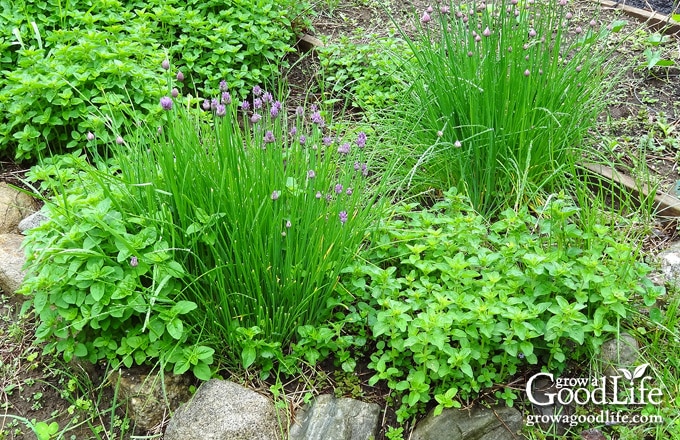
Oregano as a Companion Plant
Oregano is more than just a flavorful addition to your recipes. It can also benefit other plants in your garden when planted nearby. Companion planting is a method of strategically placing plants together to promote growth, control pests, and improve overall health. Here are some benefits of growing oregano as a companion plant:
- Pest Control: Oregano emits a strong scent that naturally repels many garden pests, including aphids, cabbage moths, and cucumber beetles. By interplanting oregano with susceptible crops, you can help deter pests. Consider planting oregano near tomatoes, peppers, eggplants, and other nightshade family members to discourage pests. Additionally, consider planting oregano in-between cabbage, broccoli, Brussels sprouts, and all other Brassicas plants so it can repel cabbage moths.
- Attract Beneficial Insects: Oregano’s flowers are attractive to beneficial insects such as bees, butterflies, and predatory wasps. These insects are crucial in pollinating and preying on harmful garden pests. Having oregano in your garden can create a welcoming environment for these beneficial insects, which can help maintain a balanced ecosystem.
If you want to benefit from oregano’s companion planting properties while keeping the plants under control, consider growing them in containers. This way, you can easily move the containers around the garden to avoid overcrowding and place them among other plants.
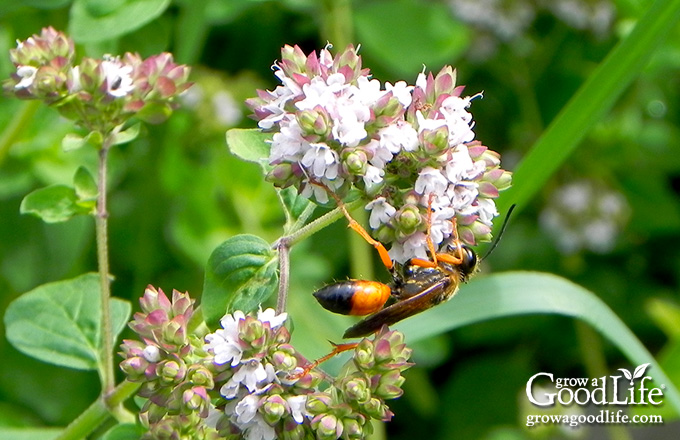
Harvesting Oregano
Once the oregano plants have grown and their stems are at least 6 inches tall, you can harvest them for meals as needed. You can either pick individual leaves or cut a few stems and remove the leaves for immediate use. Limit your harvest to one-third of the foliage so you don’t stress the plant.
Harvest oregano leaves by pinching them off from the tips of the stems above a pair of leaves. Harvest stems by cutting just above a set of leaves. This method encourages the plant to branch from the cut area, producing more flavorful leaves for future harvests.
If you plan to preserve a larger batch of oregano, it is best to harvest just before the plant begins to flower. At this stage, the leaves contain the highest concentration of essential oils, contributing to their flavor and aroma.
Use scissors or pruning shears to cut each stem just above a set of leaves, similar to selective harvesting. This practice ensures that the plant continues to produce new growth and remains healthy. Be sure to leave some of the plant’s blossoms so it can flower and attract pollinators to your garden.
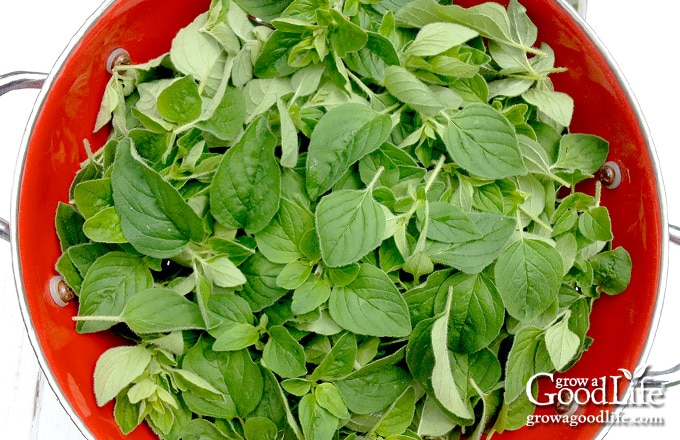
Ways to Preserve Oregano
Drying or freezing are the two best options for preserving your oregano. Both methods are highly effective.
- Dehydrating Oregano: You can dry oregano by air-drying or using a food dehydrator. Once completely dry, remove the leaves from the stems and store them in an airtight container. Check out this article to learn How to Dry Oregano.
- Freezing Oregano: Another preservation method is freezing. Wash and pat dry the oregano leaves, then place them in a single layer on a baking sheet. Put the sheet in the freezer until the leaves are frozen, and then transfer them to a freezer-safe container or bag. Frozen oregano can be used directly in cooking.
- Canning Recipes: In its dried form, oregano can be used as a flavoring in many canning recipes including: seasoned tomato sauce, roasted red peppers, green tomato salsa, and spaghetti sauce.
By harvesting oregano at the right time and utilizing proper preservation techniques, you can enjoy the flavor and aroma of this versatile herb throughout the year.
Ways to Use Oregano
Whether using fresh or dried oregano, the leaves can be added to a wide variety of dishes. Add it to sauces, soups, salads, marinades, and more for a burst of flavor. Here are some examples:
- Tomato Sauce: Add oregano to homemade tomato sauce for a classic Italian flavor that pairs perfectly with pasta dishes and pizzas.
- Roasted Vegetables: Sprinkle oregano over roasted vegetables like zucchini, eggplant, bell peppers, and roasted root vegetables to add a savory and aromatic touch.
- Italian Recipes: Use oregano in Italian-inspired recipes such as zucchini lasagna, Italian salsa cruda, and zucchini garlic bites for an authentic taste.
- Roasted Turkey: Rub oregano and other herbs and spices onto a roasted turkey to infuse delicious flavors and create a mouthwatering Thanksgiving centerpiece.
- Meatballs: Mix oregano into meatballs or meatloaf recipes for added flavor in these classic comfort foods.
- Soups and Stews: Add fresh or dried oregano to soups and stews for a savory and aromatic boost.
- Salad Dressing: Mix oregano into homemade salad dressings and vinaigrettes for a burst of herbal freshness.
- Herb Butters: Incorporate oregano into herb butter or compound butter to spread over warm bread or melt onto grilled steaks.
These are just a few examples, and the possibilities are endless when it comes to using oregano to enhance the taste and aroma of your favorite dishes.
—
Congratulations on embarking on your oregano-growing journey! With the knowledge and tips shared in this guide, you’ll soon enjoy this versatile herb’s beauty and culinary delights in your home or garden.
Dig deeper and add to your herb garden knowledge with these growing guides:
- How to Grow Parsley
- How to Grow Thyme
- How to Grow Chives
- How to Grow Dill
- How to Grow Cilantro
- How to Rosemary
- How to Basil
Good planning is key to a successful vegetable garden
Whether you are new to growing your own food or have been growing a vegetable garden for years, you will benefit from some planning each year. You will find everything you need to organize and plan your vegetable garden in my PDF eBook, Grow a Good Life Guide to Planning Your Vegetable Garden.

